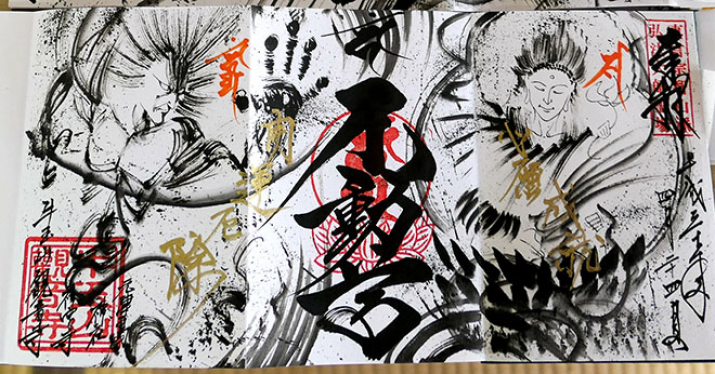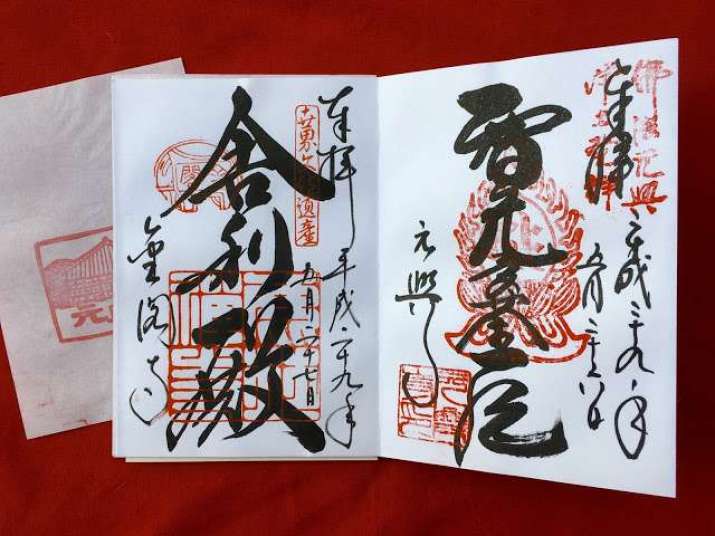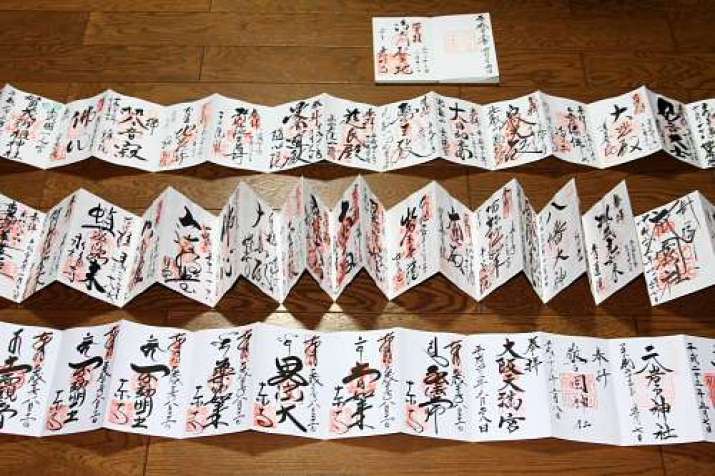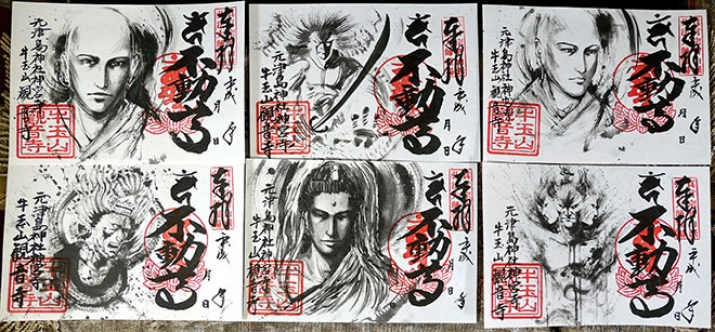NEWS
Japanese Buddhist Priest Transforms Traditional Goshuin Stamps into Works of Art
 A three-page goshuin seal stamp created by Yu Hasegawa featuring Buddhist deities of Fudo Myoo and Kannon Bodhisattva. Photo by Chieko Hara. From asahi.com
A three-page goshuin seal stamp created by Yu Hasegawa featuring Buddhist deities of Fudo Myoo and Kannon Bodhisattva. Photo by Chieko Hara. From asahi.comYu Hasegawa, the 27-year-old vice head priest at Kannon-ji, a Buddhist temple in Tsushima, in Japan’s Aichi Prefecture, is drawing in new visitors to his temple by adding elaborate illustrations to the temple’s traditional goshuin stamps.
Hasegawa completes the goshuin seal stamps featuring not only traditional text but also depictions of the Buddhist deity Fudo Myoo, the bodhisattva Kannon, the temple’s principal Buddhist statue, and the animals of the zodiac, in as little as 15 minutes, leaving worshippers in awe of his skills.
According to The Asahi Shimbun newspaper, Hasegawa recently won as award for new talent organized by the publisher of the Evening comic anthology for young adults, a popular manga series in Japan.
“I think it [the drawings] goes beyond the boundaries of goshuin to some extent, but I want to take on a challenge and work on wide-ranging illustrations and requests without being tied to Buddhist paintings,” said Hasegawa. (The Asahi Shimbun)
 The goshuin of Gango-ji in Nara, right, and Kinkaku-ji in Kyoto, left. From fiveyearsproject.blogspot.com
The goshuin of Gango-ji in Nara, right, and Kinkaku-ji in Kyoto, left. From fiveyearsproject.blogspot.com Goshuin-cho filled with stamps. From kyotoursjapan.com
Goshuin-cho filled with stamps. From kyotoursjapan.comThe goshuin (御朱印) or shuin (朱印 [go is a Japanese honorific prefix]) is a stamp given to visitors of Buddhist temples and Shinto shrines in Japan. Shuin literally translates as “red stamp;” shu (朱) is red/orange ink, the familair vermilion colour often sees at temples and shrines in Japan, while in (印) translates as stamp. Each temple has its own shuin design, and it usually includes the name of the temple, the name of the deity, the date of the visit, and sometimes words of blessing or parts of Buddhist scriptures written in ink by a priest. On top of the calligraphy, various vermillion stamps are placed using stamps that have been handcarved by the priests who live at the temple or shrine.
There are many theories about the origin of goshuin, but the most popular is that it was originally meant as a “receipt” for the donation of a copied sutra (shakyo). The goshuin is still very much a living part of Japanese religious culture and people travel all over to collect the stamps in their goshuin-cho—a special notebook for the stamps that can be obtained at a temple. Some temples still only give out goshuin in exchange for a sutra or a donation, but many temples now accept a small sum in exchange (usually around 300 yen [US$3], with some temples asking up to 1,000 yen [US$9]).
 Other goshuin stamps drawn by Yu Hasegawa. Photo by Chieko Hara. From asahi.com
Other goshuin stamps drawn by Yu Hasegawa. Photo by Chieko Hara. From asahi.com
A "regular" goshuin being written at Kiyomizu-dera in Kyoto, Japan. From youtube.com
Before joining Kannon-ji last spring, Hasegawa trained for a year at Chishakuin Temple in Kyoto, headquarters of the Chisan school of the Shingon sect of Japanese Buddhism. He also continued his studies in college before starting to send his manga works to publishers. When he joined Kannon-ji, the chief priest Kaishin Hasegawa asked him to take charge of the temple’s goshuin. Despite his poor handwriting (priest sgiving out goshuin are usually skilled caligraphers), Yu Hasegawa decided to take on the job as he was confident in his drawing skills.
Although Kannon-ji is a temple of historical significance and was once placed under the protection of feudal warlord Oda Nobunaga (1534–82), it is not a major attraction for tourists or pilgrims. However, as word of Hasegawa’s goshuin spread, visitor numbers to the temple rose significantly. Hasegawa drew at least 3,000 goshuin last year, with more than 100 people lining up for stamps during the peak season. The temple has now opened up a registration system for all those interested in obtaining the unique stamp.
See more
Priest in demand for artistic work on temple’s ‘goshuin’ stamps (The Asahi Shimbun)
Try receiving shuin (temple seal) at Buddhist temples and Shinto shrines (Japan Hoppers)
Shuin (Wikipedia)
Related news from Buddhistdoor Global
Chinese and Japanese Scholars Celebrate Reproduction of Song Dynasty Tripitaka
Buddhist Temples Across Japan Soon to Offer Rented Accommodation for Tourists
180 Artifacts Discovered in Ancient Statue of the Bodhisattva Manjushri
Japanese Monk Sues Buddhist Temple Over Heavy Workload
Ancient Buddhist Artifacts from Afghanistan Restored in Japan
Related features from Buddhistdoor Global
The Propagation of Fudō Iconography in Japan
Mindfulness Practice in Japanese Stroll Gardens
One Face of Liberation: Buddhist Feminism in Japan
Expressions between Dogma and Silence: A Japanese Take on the Two Truths














